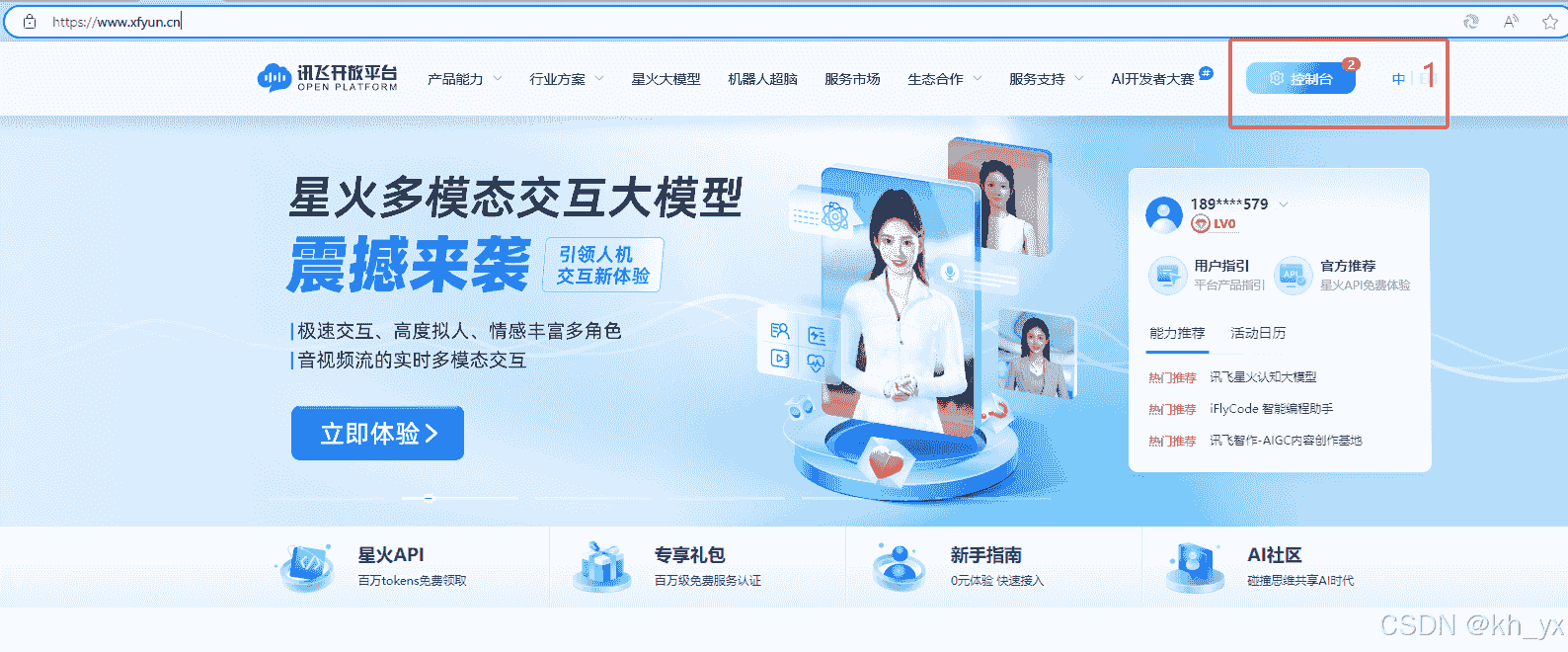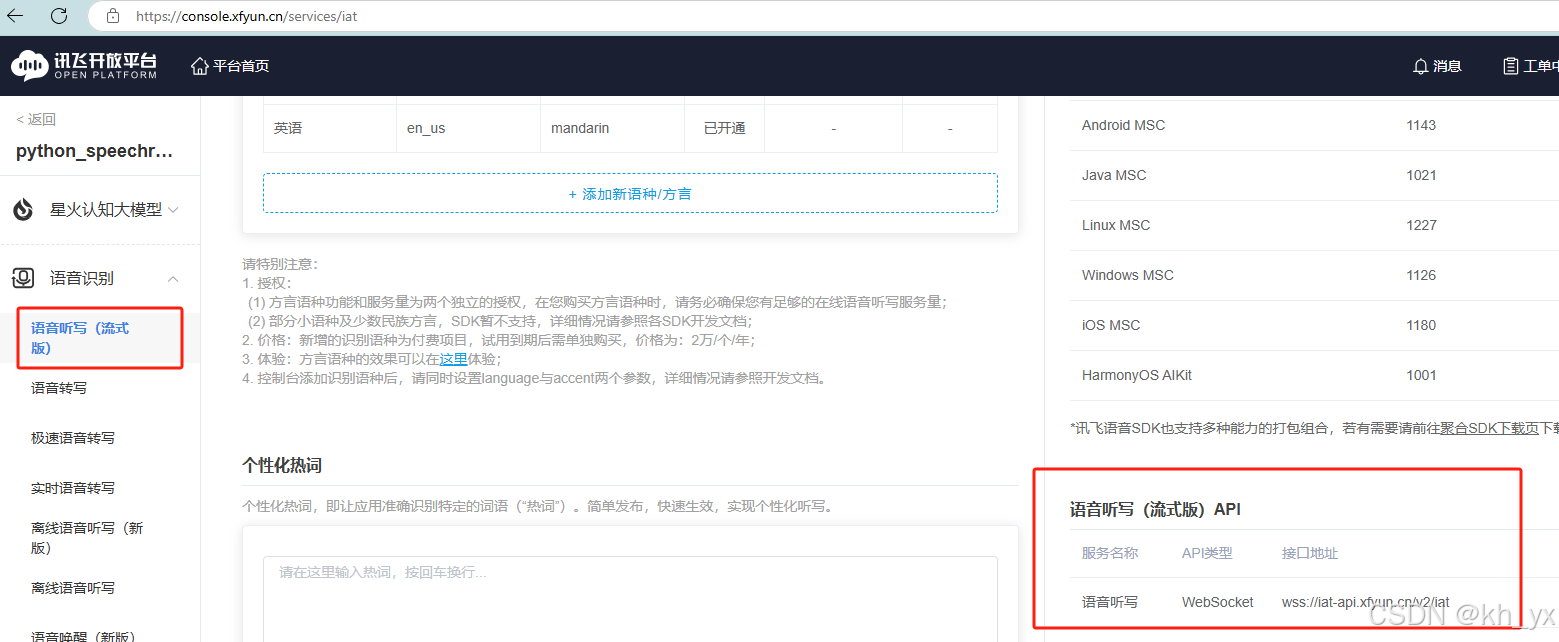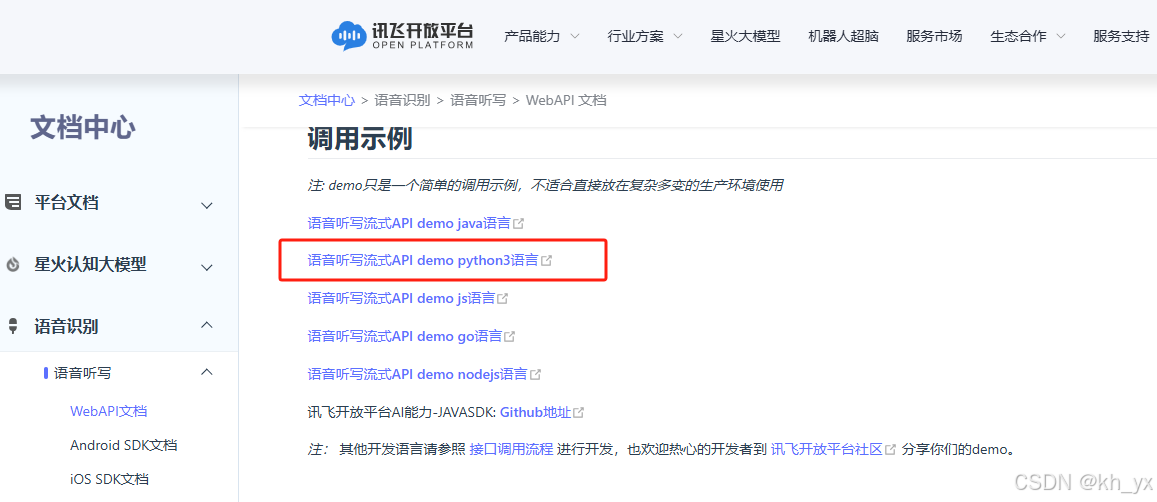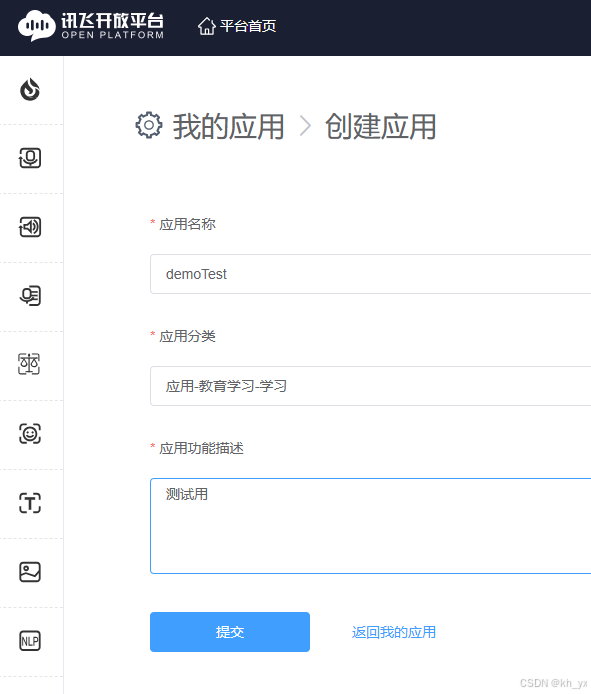前言
基于python3 讯飞webapi语音识别 接口调用的实现。
一、环境
1、注册讯飞平台账号:讯飞平台网址
2、进入控制台并创建应用

 |
|
3、进入应用后点击右侧语音识别-语音听写,系统会生成服务端口认证信息appid、apisecret、apikey,后面调用接口的时候会用到,往下滑动可看到接口地址


二、引入库
需要提前安装所需的库
使用pip安装
python -m pip install websocket-client
import websocket import datetime import hashlib import base64 import hmac import json from urllib.parse import urlencode import time import ssl from wsgiref.handlers import format_date_time from datetime import datetime from time import mktime import _thread as thread
三、代码实例
1、进入讯飞资料文档中心:语音听写(流式版)webapi 文档 | 讯飞开放平台文档中心
下载python3 demo

demo中的on_message方法需要小小的改动,在输出完整的数据之前先进行判断是否已经是最后一帧了。已在下面的代码中体现
下列代码中的appid、apisecret、apikey、url根据标题一中3步骤的内容更改
import websocket
import datetime
import hashlib
import base64
import hmac
import json
from urllib.parse import urlencode
import time
import ssl
from wsgiref.handlers import format_date_time
from datetime import datetime
from time import mktime
import _thread as thread
status_first_frame = 0 # 第一帧的标识
status_continue_frame = 1 # 中间帧标识
status_last_frame = 2 # 最后一帧的标识
class ws_param(object):
# 初始化
def __init__(self, appid, apikey, apisecret, audiofile):
self.appid = appid
self.apikey = apikey
self.apisecret = apisecret
self.audiofile = audiofile
# 公共参数(common)
self.commonargs = {"app_id": self.appid}
# 业务参数(business),更多个性化参数可在官网查看
self.businessargs = {"domain": "iat", "language": "zh_cn", "accent": "mandarin", "vinfo":1,"vad_eos":10000}
# 生成url
def create_url(self):
url = 'wss://ws-api.xfyun.cn/v2/iat'
# 生成rfc1123格式的时间戳
now = datetime.now()
date = format_date_time(mktime(now.timetuple()))
# 拼接字符串
signature_origin = "host: " + "ws-api.xfyun.cn" + "\n"
signature_origin += "date: " + date + "\n"
signature_origin += "get " + "/v2/iat " + "http/1.1"
# 进行hmac-sha256进行加密
signature_sha = hmac.new(self.apisecret.encode('utf-8'), signature_origin.encode('utf-8'),
digestmod=hashlib.sha256).digest()
signature_sha = base64.b64encode(signature_sha).decode(encoding='utf-8')
authorization_origin = "api_key=\"%s\", algorithm=\"%s\", headers=\"%s\", signature=\"%s\"" % (
self.apikey, "hmac-sha256", "host date request-line", signature_sha)
authorization = base64.b64encode(authorization_origin.encode('utf-8')).decode(encoding='utf-8')
# 将请求的鉴权参数组合为字典
v = {
"authorization": authorization,
"date": date,
"host": "ws-api.xfyun.cn"
}
# 拼接鉴权参数,生成url
url = url + '?' + urlencode(v)
# print("date: ",date)
# print("v: ",v)
# 此处打印出建立连接时候的url,参考本demo的时候可取消上方打印的注释,比对相同参数时生成的url与自己代码生成的url是否一致
# print('websocket url :', url)
return url
# 收到websocket消息的处理
all_results = ""
def on_message(ws, message):
global all_results
try:
code = json.loads(message)["code"]
sid = json.loads(message)["sid"]
if code != 0:
errmsg = json.loads(message)["message"]
print("sid:%s call error:%s code is:%s" % (sid, errmsg, code))
else:
data = json.loads(message)["data"]["result"]["ws"]
# print(json.loads(message))
result = ""
for i in data:
tm = str(i["bg"])
for w in i["cw"]:
result += w["w"]
# 添加到全局结果
all_results += result
# 检查是否为最后一帧
if "status" in json.loads(message)["data"]:
if json.loads(message)["data"]["status"] == 2: # 判断是否为最后一帧
print("sid:%s call success!, combined data is: %s" % (sid, all_results)) # 添加句号到最后
all_results = "" # 清空全局结果
#print("sid:%s call success!,data is:%s" % (sid, json.dumps(data, ensure_ascii=false)))
#print("sid:%s call success!,data is:%s" % (sid, result))
except exception as e:
print("receive msg,but parse exception:", e)
# 收到websocket错误的处理
def on_error(ws, error):
print("### error:", error)
# 收到websocket关闭的处理
def on_close(ws,a,b):
print("### closed ###")
# 收到websocket连接建立的处理
def on_open(ws):
def run(*args):
framesize = 8000 # 每一帧的音频大小
intervel = 0.04 # 发送音频间隔(单位:s)
status = status_first_frame # 音频的状态信息,标识音频是第一帧,还是中间帧、最后一帧
with open(wsparam.audiofile, "rb") as fp:
while true:
buf = fp.read(framesize)
# 文件结束
if not buf:
status = status_last_frame
# 第一帧处理
# 发送第一帧音频,带business 参数
# appid 必须带上,只需第一帧发送
if status == status_first_frame:
d = {"common": wsparam.commonargs,
"business": wsparam.businessargs,
"data": {"status": 0, "format": "audio/l16;rate=16000",
"audio": str(base64.b64encode(buf), 'utf-8'),
"encoding": "raw"}}
d = json.dumps(d)
ws.send(d)
status = status_continue_frame
# 中间帧处理
elif status == status_continue_frame:
d = {"data": {"status": 1, "format": "audio/l16;rate=16000",
"audio": str(base64.b64encode(buf), 'utf-8'),
"encoding": "raw"}}
ws.send(json.dumps(d))
# 最后一帧处理
elif status == status_last_frame:
d = {"data": {"status": 2, "format": "audio/l16;rate=16000",
"audio": str(base64.b64encode(buf), 'utf-8'),
"encoding": "raw"}}
ws.send(json.dumps(d))
time.sleep(1)
break
# 模拟音频采样间隔
time.sleep(intervel)
ws.close()
thread.start_new_thread(run, ())
if __name__ == "__main__":
# 测试时候在此处正确填写相关信息即可运行
time1 = datetime.now()
wsparam = ws_param(appid='xxx', apisecret='xxx',
apikey='xxx',
audiofile=r'c:\users\1\downloads\iat_pcm_8k.pcm')
websocket.enabletrace(false)
wsurl = wsparam.create_url()
ws = websocket.websocketapp(wsurl, on_message=on_message, on_error=on_error, on_close=on_close)
ws.on_open = on_open
ws.run_forever(sslopt={"cert_reqs": ssl.cert_none})
time2 = datetime.now()
print(time2-time1) 四、运行结果

五、总结
modulenotfounderror: no module named 'websocket'
attributeerror: module 'websocket' has no attribute 'enabletrace'
以上错误需要安装websocket-client库即可解决
到此这篇关于讯飞webapi语音识别接口调用的文章就介绍到这了,更多相关讯飞webapi语音识别接口调用python内容请搜索代码网以前的文章或继续浏览下面的相关文章希望大家以后多多支持代码网!







发表评论